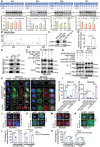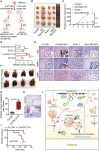Hypoxia-Induced FUS-circTBC1D14 Stress Granules Promote Autophagy in TNBC
- PMID: 36806670
- PMCID: PMC10074116
- DOI: 10.1002/advs.202204988
Hypoxia-Induced FUS-circTBC1D14 Stress Granules Promote Autophagy in TNBC
Abstract
Triple-negative breast cancer (TNBC) is a highly aggressive subtype of breast cancer that is suggested to be associated with hypoxia. This study is the first to identify a novel circular RNA (circRNA), circTBC1D14, whose expression is significantly upregulated in TNBC. The authors confirm that high circTBC1D14 expression is associated with a poor prognosis in patients with breast cancer. circTBC1D14-associated mass spectrometry and RNA-binding protein-related bioinformatics strategies indicate that FUS can interact with circTBC1D14, which can bind to the downstream flanking sequence of circTBC1D14 to induce cyclization. FUS is an essential biomarker associated with stress granules (SGs), and the authors find that hypoxic conditions can induce FUS-circTBC1D14-associated SG formation in the cytoplasm after modification by protein PRMT1. Subsequently, circTBC1D14 increases the stability of PRMT1 by inhibiting its K48-regulated polyubiquitination, leading to the upregulation of PRMT1 expression. In addition, FUS-circTBC1D14 SGs can initiate a cascade of SG-linked proteins to recognize and control the elimination of SGs by recruiting LAMP1 and enhancing lysosome-associated autophagy flux, thus contributing to the maintenance of cellular homeostasis and promoting tumor progression in TNBC. Overall, these findings reveal that circTBC1D14 is a potential prognostic indicator that can serve as a therapeutic target for TNBC treatment.
Keywords: autophagy; circTBC1D14; fused in sarcoma (FUS); hypoxia; stress granule.
© 2023 The Authors. Advanced Science published by Wiley-VCH GmbH.
Conflict of interest statement
The authors declare no conflict of interest.
Figures







Similar articles
-
The effect of PRMT1-mediated arginine methylation on the subcellular localization, stress granules, and detergent-insoluble aggregates of FUS/TLS.PLoS One. 2012;7(11):e49267. doi: 10.1371/journal.pone.0049267. Epub 2012 Nov 13. PLoS One. 2012. PMID: 23152885 Free PMC article.
-
Arginine methylation by PRMT1 regulates nuclear-cytoplasmic localization and toxicity of FUS/TLS harbouring ALS-linked mutations.Hum Mol Genet. 2012 Jan 1;21(1):136-49. doi: 10.1093/hmg/ddr448. Epub 2011 Sep 28. Hum Mol Genet. 2012. PMID: 21965298
-
Autophagy regulates amyotrophic lateral sclerosis-linked fused in sarcoma-positive stress granules in neurons.Neurobiol Aging. 2014 Dec;35(12):2822-2831. doi: 10.1016/j.neurobiolaging.2014.07.026. Epub 2014 Jul 27. Neurobiol Aging. 2014. PMID: 25216585
-
Stress granules in neurodegeneration--lessons learnt from TAR DNA binding protein of 43 kDa and fused in sarcoma.FEBS J. 2013 Sep;280(18):4348-70. doi: 10.1111/febs.12287. Epub 2013 May 9. FEBS J. 2013. PMID: 23587065 Review.
-
"STRESSED OUT": The role of FUS and TDP-43 in amyotrophic lateral sclerosis.Int J Biochem Cell Biol. 2020 Sep;126:105821. doi: 10.1016/j.biocel.2020.105821. Epub 2020 Aug 3. Int J Biochem Cell Biol. 2020. PMID: 32758633 Review.
Cited by
-
The therapeutic potential of circular RNA in triple-negative breast cancer.Cancer Drug Resist. 2024 Apr 23;7:13. doi: 10.20517/cdr.2023.141. eCollection 2024. Cancer Drug Resist. 2024. PMID: 38835343 Free PMC article. Review.
-
Assembly and disassembly of stress granules in kidney diseases.iScience. 2025 May 24;28(6):112578. doi: 10.1016/j.isci.2025.112578. eCollection 2025 Jun 20. iScience. 2025. PMID: 40546967 Free PMC article. Review.
-
circZNF707 promoted glycolysis and tumor progression through miR-668-3p-PFKM axis in NSCLC.Eur J Med Res. 2025 Feb 27;30(1):141. doi: 10.1186/s40001-025-02359-z. Eur J Med Res. 2025. PMID: 40016838 Free PMC article.
-
Integrated transcriptomic and metabolomic analysis reveals the metabolic programming of GM-CSF- and M-CSF- differentiated mouse macrophages.Front Immunol. 2023 Sep 25;14:1230772. doi: 10.3389/fimmu.2023.1230772. eCollection 2023. Front Immunol. 2023. PMID: 37818352 Free PMC article.
-
Regulation of Different Types of Cell Death by Noncoding RNAs: Molecular Insights and Therapeutic Implications.ACS Pharmacol Transl Sci. 2025 Apr 30;8(5):1205-1226. doi: 10.1021/acsptsci.4c00681. eCollection 2025 May 9. ACS Pharmacol Transl Sci. 2025. PMID: 40370994 Review.
References
Publication types
MeSH terms
Substances
Grants and funding
- 2020YFA0712400/National Key Research and Development Program
- ts20190971/Special Foundation for Taishan Scholars
- 81874119/National Natural Science Foundation of China
- 82072912/National Natural Science Foundation of China
- 81972475/National Natural Science Foundation of China
- 81902697/National Natural Science Foundation of China
- W01020103/Special Support Plan for National High-Level Talents
- 2020SDUCRCA015/Foundation from Clinical Research Center of Shandong University
- 2018-7/Qilu Hospital Clinical New Technology Developing Foundation
- 2019-3/Qilu Hospital Clinical New Technology Developing Foundation
- 2019GSF108140/The Key Research and Development Program of Shandong Province
- 2019T120593/Chinese Postdoctoral Science Foundation
- 2018M630787/Chinese Postdoctoral Science Foundation
LinkOut - more resources
Full Text Sources
Medical
Miscellaneous
